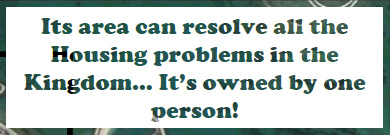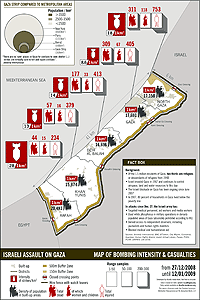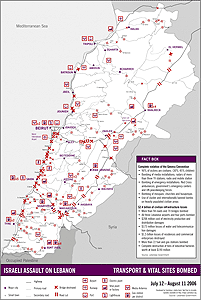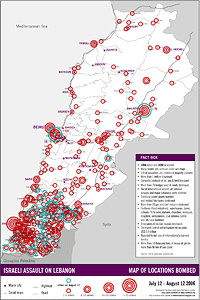israel
Stuxnet: Anatomy of a Computer Virus
Stylish and powerful infographic on the nature and ramifications of the computer virus Stuxnet.
While not the first time that crackers have targeted industrial systems, Stuxnet is the first discovered malware that spies on and subverts specific industrial systems and is widely suspected of targeting the uranium enrichment infrastructure in Iran.
Patrick Clair designed and directed the animation for the Australian television program Hungry Beast.
This may be old news (Stuxnet was discovered a year ago,) but the consequences are still playing out.

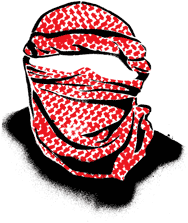
Google Earth and the Middle East
Ogle Earth runs down a brief list of ways Google Earth and the availability of satellite imagery in recent years have fueled class resentment and conflict in Bahrain, Iran, Iraq, Israel, Saudi Arabia, Sudan, Syria, Tunisia, and Yemen.
Leading the list are dramatic visualizations comparing the overcrowded living conditions of the Shiite majority in Bahrain with the palaces, estates, and private islands of the ruling families. After the country’s ISPs were ordered to block access to Google Earth’s imagery in 2006, this PDF of annotated screencaps illustrating the spatial inequities circulated widely by email.
 A call for Israeli architects and planners to refuse to design settlements in Ariel, a sliver of land that goes deep into Palestinian territory: “After dozens of actors, theater workers, professors and writers declared their refusal to appear in the new cultural hall in Ariel or any other settlement, the time has come for architects and planners to wake up and announce publicly that they will not continue planning new buildings in the settlements. Architects and planners are the ones who implement in practice the occupation policy of Israeli governments and continue the conflict on the drafting table.” (via)
A call for Israeli architects and planners to refuse to design settlements in Ariel, a sliver of land that goes deep into Palestinian territory: “After dozens of actors, theater workers, professors and writers declared their refusal to appear in the new cultural hall in Ariel or any other settlement, the time has come for architects and planners to wake up and announce publicly that they will not continue planning new buildings in the settlements. Architects and planners are the ones who implement in practice the occupation policy of Israeli governments and continue the conflict on the drafting table.” (via)Update 9/6/2010: More than 150 US and UK actors, writers, and directors have signed a letter of support for the Israeli actors who said they would not perform in Ariel.
Bricks and Mortars

While the conflict in Israel and Palestine is a war for dominance, territory, hearts and minds, it is also a war on, and of, the built environment: bulldozing and bombing homes, laying and rerouting roads, checkpoints, the separation wall, and, of course, the settlements.
After the Israeli assault on Gaza that began in December 2008, the Israeli army banned the import of cement. This is particularly pressing since homes, hospitals, schools, water networks cannot be rebuilt.
While some are designing around the ban, developing mud brick architecture and off-grid lighting systems, other activists have flouted the ban sending Gaza cement themselves. And though Israel eased a total ban on construction materials in late July, only 41 truckloads of construction materials were allowed to enter Gaza in 2009. Thousands more are needed.
Last week, on the anniversary of the assault, a group of sixteen human rights and humanitarian organizations accused the international community of betraying the people of Gaza by failing to end the Israeli blockade. Meanwhile, the Western media has not only ignored demonstrations within Israel and without, but even softened the impact of the blockade.
Update 1/6/10: Al Jazeera has another angle on design, the blockade, and the built environment: a write-up of graffiti culture in Gaza. Without access to uncensored news, some activists have turned to graffiti — and were even occasionally sponsored, supplied, and trained by Hamas or Fatah. (via)

Worn on its Sleeve
The chattering classes are aflutter that the President of Iran yesterday called Israel “a cruel and repressive racist regime” at the UN Conference on Racism. 23 diplomats stormed out, others applauded. While Ahmadinejad has said some pretty outrageous things, in this case I wonder if he saw this latest item in the Israeli daily Haaretz about T-shirt designs Israeli soldiers are ordering for their IDF units. The shirts boast slogans and images of dead Palestinian babies, bombed mosques, jokes about rape, sniping children, killing pregnant women in Hijab, etc. The designs are revealing. This is clearly not a military culture solely preoccupied with defending the integrity of the State.
Solidarity Maps
The maps below visualize some of the impact of Israeli attacks on civilians and civilian infrastructure in Lebanon and the Gaza Strip. About the designers:
“We are a group of Lebanese a group of Lebanese, Palestinian, and other activists who have worked together previously, mainly doing media and mapping work during the summer 2006 Israeli attack on Lebanon, and some of us later on advocacy and design for the reconstruction of Nahr el-Bared refugee camp. We have among us designers, architects, researchers, media people, and many other random activists. Although we are not an organised body or politically affiliated with a specific group, we are all pro-Palestinian.”


